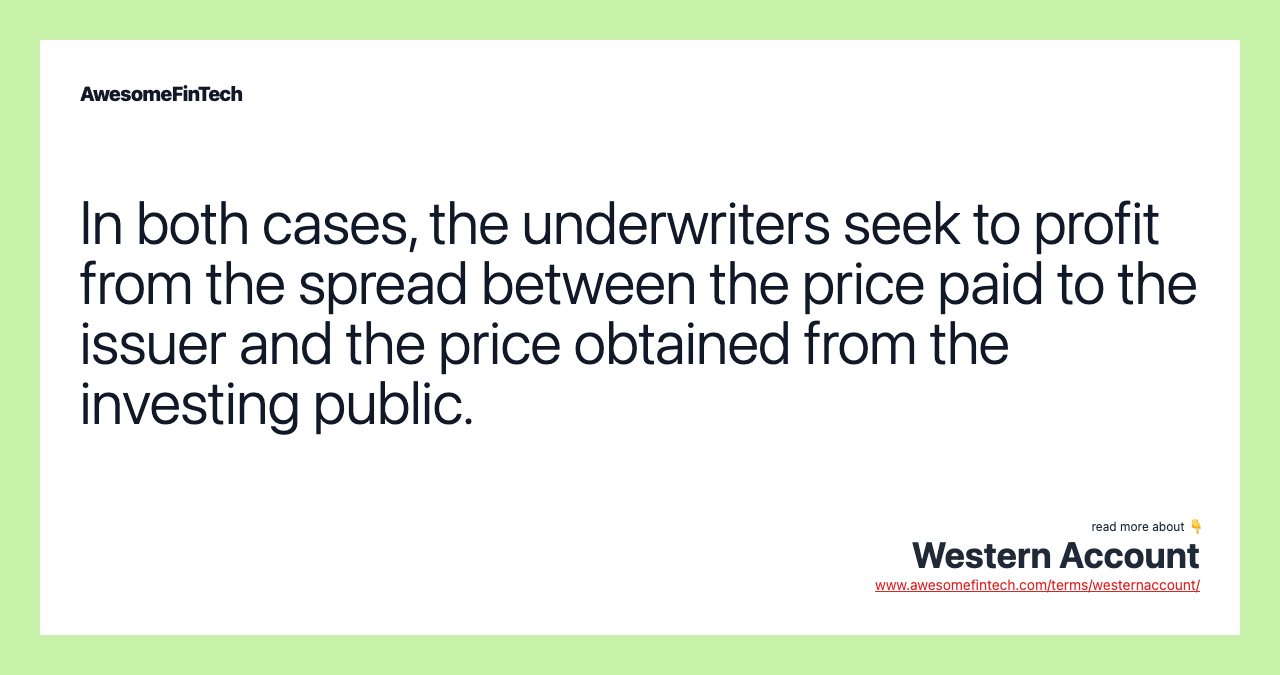Western Account
A western account is a type of agreement among underwriters (AAU) in which each underwriter agrees to share responsibility for only a specific portion of the overall new issuance. A western account is a type of agreement among underwriters (AAU) in which each underwriter agrees to share responsibility for only a specific portion of the overall new issuance. The western account is one of the ways that underwriters seek to manage the risk associated with bringing new securities to the public, such as in the case of an initial public offering (IPO). A western account is a type of AAU in which the parties to an underwriting consortium agree to be responsible only for their own allocation of the new securities issuance. The profit of the underwriter is based on the spread between the price paid to the issuer and the price ultimately obtained from selling the new securities to the public.

What Is a Western Account?
A western account is a type of agreement among underwriters (AAU) in which each underwriter agrees to share responsibility for only a specific portion of the overall new issuance. They are the opposite of an “eastern account,” in which each underwriter shares responsibility for the entire issuance.
Western accounts are popular among some underwriters because they reduce their effective liability should the new issuance prove more difficult than expected. On the other hand, western accounts also limit the potential upside enjoyed by underwriters in the event that the new issuance is unusually successful.



How Western Accounts Work
The western account is one of the ways that underwriters seek to manage the risk associated with bringing new securities to the public, such as in the case of an initial public offering (IPO). These transactions are inherently risky for the underwriters involved, because they are required to pay a certain amount of money to the issuer of the security regardless of the price at which those securities can then be sold to the public. The profit of the underwriter is based on the spread between the price paid to the issuer and the price ultimately obtained from selling the new securities to the public.
To mitigate this risk, underwriters generally conduct new issuances in collaboration with one another, forming what are known as underwriting “consortiums.” Of course, when bringing together several underwriting firms in this manner, it is necessary to clearly delineate the rights and responsibilities of the parties involved. This is accomplished through explicit agreements known as AAUs, which lay out which underwriter is responsible for which portion of the new issuance.
The western account, also known as a “divided account,” is simply one common example of an AAU structure. In it, each underwriter agrees to take on liability for only the portion of the issuance that it takes into its own inventory. If any of the securities held by other underwriters fail to sell (or obtain disappointing prices), then that risk is only born by the specific underwriter left holding that inventory.
Example of a Western Account
XYZ Corporation is a prominent manufacturing company preparing for its IPO. Its management team are experts in their industry, but are not especially knowledgeable about the financial markets. For this reason, they hire a lead underwriter who in turn forms a consortium of firms who are collectively responsible for carrying out XYZ’s IPO.
Under the terms of this transaction, XYZ is paid a sum by the underwriters that is equivalent to $25 per share. In order to profit from the transaction, the underwriting consortium must seek to sell their shares to other investors for greater than $25 per share.
In forming their consortium, XYZ’s underwriters adopted an AAU modeled on the western account structure. Accordingly, each of the underwriting firms involved only assumed responsibility for a specific portion of the newly issued shares. For this reason, the ultimate profit or loss of the underwriters will vary from one firm to the next.
Related terms:
Financial Markets
Financial markets refer broadly to any marketplace where the trading of securities occurs, including the stock market and bond markets, among others. read more
Inventory :
Inventory is the term for merchandise or raw materials that a company has on hand. read more
Initial Public Offering (IPO)
An initial public offering (IPO) refers to the process of offering shares of a private corporation to the public in a new stock issuance. read more
Issuer
An issuer is a legal entity that develops, registers and sells securities for the purpose of financing its operations. read more
New Issue
A new issue refers to a new security, whether a stock or bond, being issued for the first time. IPO's are the most common form of new issues. read more
Reallowance
A reallowance is an incentive paid to a broker-dealer who is not part of the issue underwriting syndicate to sell newly issued shares. read more
Security : How Securities Trading Works
A security is a fungible, negotiable financial instrument that represents some type of financial value, usually in the form of a stock, bond, or option. read more
Selling Group
A selling group comprises all financial institutions involved in selling or marketing a new or secondary issue of debt or equity. read more